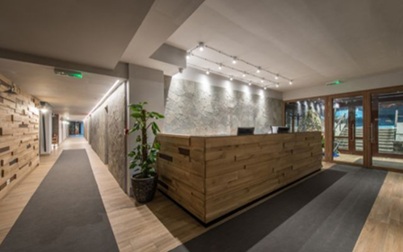 NATIONAL REPORT—Flooring upgrades often drive long-term sustainability goals in lodging operations, particularly when considering material sourcing, maintenance, and guest expectations. Lodge owners face pressure to select products that reduce environmental impact while still appealing to eco-minded travelers and commercial facility standards. Understanding the differences between flooring can help owners plan renovations and retrofits that align with both branding and performance expectations.
NATIONAL REPORT—Flooring upgrades often drive long-term sustainability goals in lodging operations, particularly when considering material sourcing, maintenance, and guest expectations. Lodge owners face pressure to select products that reduce environmental impact while still appealing to eco-minded travelers and commercial facility standards. Understanding the differences between flooring can help owners plan renovations and retrofits that align with both branding and performance expectations.
Environmental Manufacturing Footprint
Laminate flooring utilizes synthetic cores layered with printed visuals, often relying on adhesives and resins that have higher energy demands. Wood products, on the other hand, originate from harvested timber, and sustainably sourced hardwoods can contribute to lower emissions and less synthetic waste. Production processes for solid or engineered wood flooring often allow mills to reclaim waste and apply finishes without harmful VOCs.
Laminate and wood flooring in sustainable lodging operations differ in how much energy they consume and how many emissions they release during initial production. Wood earns more credits under programs like FSC and LEED due to renewable sourcing and longer use potential. Laminate sometimes integrates recycled content, but petroleum-based components often limit its rating under stricter green certifications.
Installation Waste & On-Site Impact
Wood flooring installations often involve custom cuts, thick underlayment, and adhesives that require longer setup and more disposal. Laminate planks typically snap together over foam padding, resulting in less job-site mess but relying more on synthetic components. Floating floor systems can simplify commercial retrofits, particularly when speed and odor control are key considerations.
Low-VOC adhesives and quick-install solutions minimize disruption in high-occupancy buildings, where downtime incurs financial penalties. Laminate and wood flooring in sustainable lodging operation also differ in how they affect indoor air quality and site-level waste output during setup. Facility managers need to calculate both the short-term installation labor and the long-term chemical presence when evaluating the material’s impact.
Lifecycle Maintenance & Replacement Factors
A lodging operation can refinish wood multiple times, extending its usable life far beyond that of most commercial laminates. Hotels with heavy foot traffic may prefer laminates that resist dents and scratches, but once the top layer wears down, full replacement becomes necessary. Cleaning routines for each flooring type vary depending on moisture tolerance, pH-sensitive finishes, and resistance to cleaning agents.
There are pros and cons to different hardwood species, which makes picking the right one more difficult than picking laminate. Hardwoods like maple, white oak, or hickory offer different density levels, each affecting durability, appearance, and acoustic value. Laminate simplifies maintenance, and natural wood introduces a level of comfort and refinement that can elevate a space’s perceived value.
Guest Experience & Perception
Guests often interpret real wood as a sign of authenticity, craftsmanship, and natural luxury, especially in boutique and eco-lodge settings. Laminate floors might replicate the look, but many visitors detect the difference through sound, texture, or finish.
Operators aiming to strengthen green branding frequently choose materials that reflect transparency in sourcing and tactile quality. Eco-conscious travelers expect more than aesthetic illusions—they want materials that feel intentional and thoughtfully crafted.
Cost Variables in Green Retrofitting Projects
Material and labor costs fluctuate significantly depending on scale, regional availability, and the timing of the retrofit. Imported laminates may offer budget savings, but they also add to shipping emissions. In contrast, domestically harvested wood supports regional suppliers and may qualify for tax incentives. Grants tied to LEED upgrades often prioritize renewable materials or low-impact adhesives, shifting total project value.
Disposal and recycling costs add another layer, especially during large-scale overhauls or phased replacements. Operators managing multiple properties must compare lifecycle costs alongside environmental return on investment. Strategic choices at this stage affect line items and shape the property’s future sustainability profile.






